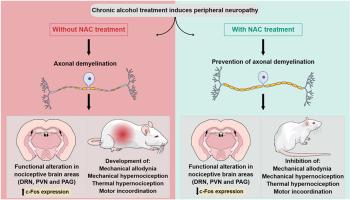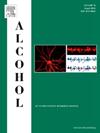n -乙酰半胱氨酸通过下调脊髓上脑区域的伤害性激活来预防乙醇诱导的神经性疼痛。
IF 2.9
4区 医学
Q3 PHARMACOLOGY & PHARMACY
引用次数: 0
摘要
考虑到n -乙酰半胱氨酸(NAC)的重要临床应用,本研究探讨了NAC治疗对乙醇诱导的神经病变的影响。为此,共使用81只雄性成年Wistar大鼠。采用38% (v/v)乙醇(10 g/kg/天,灌胃)诱导酒精性神经病变,持续10周。乙醇处理后立即给予NAC溶液(1.4 g/kg/天,口服灌胃),同样持续10周。采用电子von Frey, Randall Selitto和甩尾实验来表征机械和热刺激的伤害阈值。Rota-rod测试用于评估运动协调性,而open - field测试用于评估一般运动活动。本研究还确定了坐骨神经的完整性和关键脑结构中c-Fos免疫反应神经元的数量。正如预期的那样,长期暴露于乙醇中降低了周围神经髓鞘的厚度,并诱发了异常性疼痛、机械和热性高痛觉以及运动不协调。虽然乙醇处理没有改变一般的运动活动,但它增加了饲养事件的数量,表明增强了探索行为。在大脑中,慢性乙醇消耗与中隔背核、下丘脑室旁核的旁细胞群和大细胞群以及导水管周围灰质中c-Fos表达水平升高有关。与其保护作用一致,NAC处理阻止了所有乙醇诱导的改变的发展,包括在中央水平。综上所述,这些结果表明NAC可以持续预防乙醇诱导的神经病变。本文章由计算机程序翻译,如有差异,请以英文原文为准。

N-acetylcysteine prevents ethanol-induced neuropathic pain by downregulating nociceptive activation of supraspinal brain areas
Considering the important clinical applications of N-acetylcysteine (NAC), the present study investigated the effects of NAC treatment on ethanol-induced neuropathic alterations. For this purpose, a total number of eighty-one male adult Wistar rats were used. Alcoholic neuropathy was induced by administration of 38 % (v/v) ethanol (10 g/kg/day, oral gavage) for 10 weeks. NAC solution (1.4 g/kg/day, oral gavage) was administered immediately after ethanol treatment, also for 10 weeks. The electronic von Frey, Randall Selitto and tail flick tests were used to characterize the nociceptive thresholds to mechanical and thermal stimulations. The Rota-rod test was used to evaluate motor coordination, whereas the open field test was employed to assess general locomotor activity. The present study also determined the integrity of the sciatic nerve and the number of c-Fos immunoreactive neurons in key brain structures. As expected, long-term exposure to ethanol reduced the thickness of myelin sheath in the peripheral nerve, as well as induced allodynia, mechanical and thermal hypernociception, as well as motor incoordination. Although ethanol treatment did not alter general locomotor activity, it increased the number of rearing events, indicating enhanced exploratory behavior. In the brain, chronic ethanol consumption was associated with higher levels of c-Fos expression in the dorsal raphe nucleus, parvocellular and magnocellular groups of the hypothalamic paraventricular nucleus, and also in the periaqueductal gray. Consistent with its protective effects, NAC treatment prevented the development of all ethanol-induced alterations, including at central level. Taken together, these results suggest that NAC consistently prevents ethanol-induced neuropathy.
求助全文
通过发布文献求助,成功后即可免费获取论文全文。
去求助
来源期刊

Alcohol
医学-毒理学
CiteScore
4.60
自引率
4.30%
发文量
74
审稿时长
15.6 weeks
期刊介绍:
Alcohol is an international, peer-reviewed journal that is devoted to publishing multi-disciplinary biomedical research on all aspects of the actions or effects of alcohol on the nervous system or on other organ systems. Emphasis is given to studies into the causes and consequences of alcohol abuse and alcoholism, and biomedical aspects of diagnosis, etiology, treatment or prevention of alcohol-related health effects.
Intended for both research scientists and practicing clinicians, the journal publishes original research on the neurobiological, neurobehavioral, and pathophysiological processes associated with alcohol drinking, alcohol abuse, alcohol-seeking behavior, tolerance, dependence, withdrawal, protracted abstinence, and relapse. In addition, the journal reports studies on the effects alcohol on brain mechanisms of neuroplasticity over the life span, biological factors associated with adolescent alcohol abuse, pharmacotherapeutic strategies in the treatment of alcoholism, biological and biochemical markers of alcohol abuse and alcoholism, pathological effects of uncontrolled drinking, biomedical and molecular factors in the effects on liver, immune system, and other organ systems, and biomedical aspects of fetal alcohol spectrum disorder including mechanisms of damage, diagnosis and early detection, treatment, and prevention. Articles are published from all levels of biomedical inquiry, including the following: molecular and cellular studies of alcohol''s actions in vitro and in vivo; animal model studies of genetic, pharmacological, behavioral, developmental or pathophysiological aspects of alcohol; human studies of genetic, behavioral, cognitive, neuroimaging, or pathological aspects of alcohol drinking; clinical studies of diagnosis (including dual diagnosis), treatment, prevention, and epidemiology. The journal will publish 9 issues per year; the accepted abbreviation for Alcohol for bibliographic citation is Alcohol.
 求助内容:
求助内容: 应助结果提醒方式:
应助结果提醒方式:


